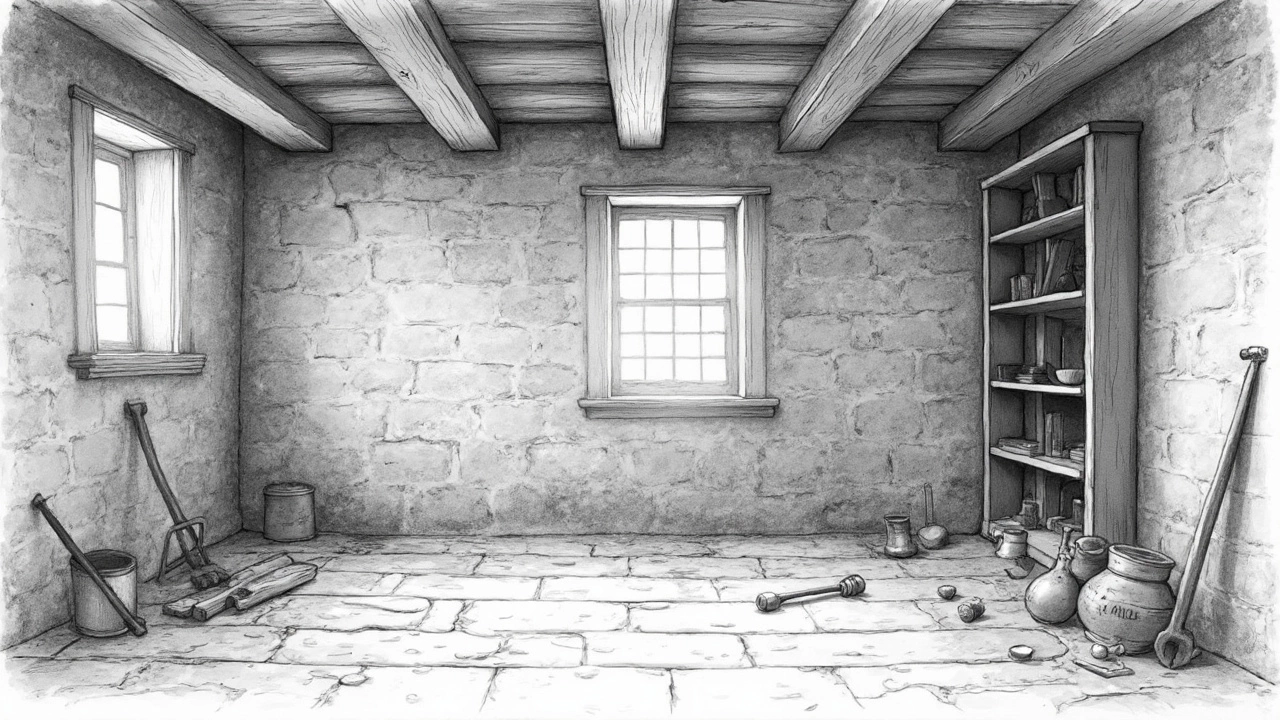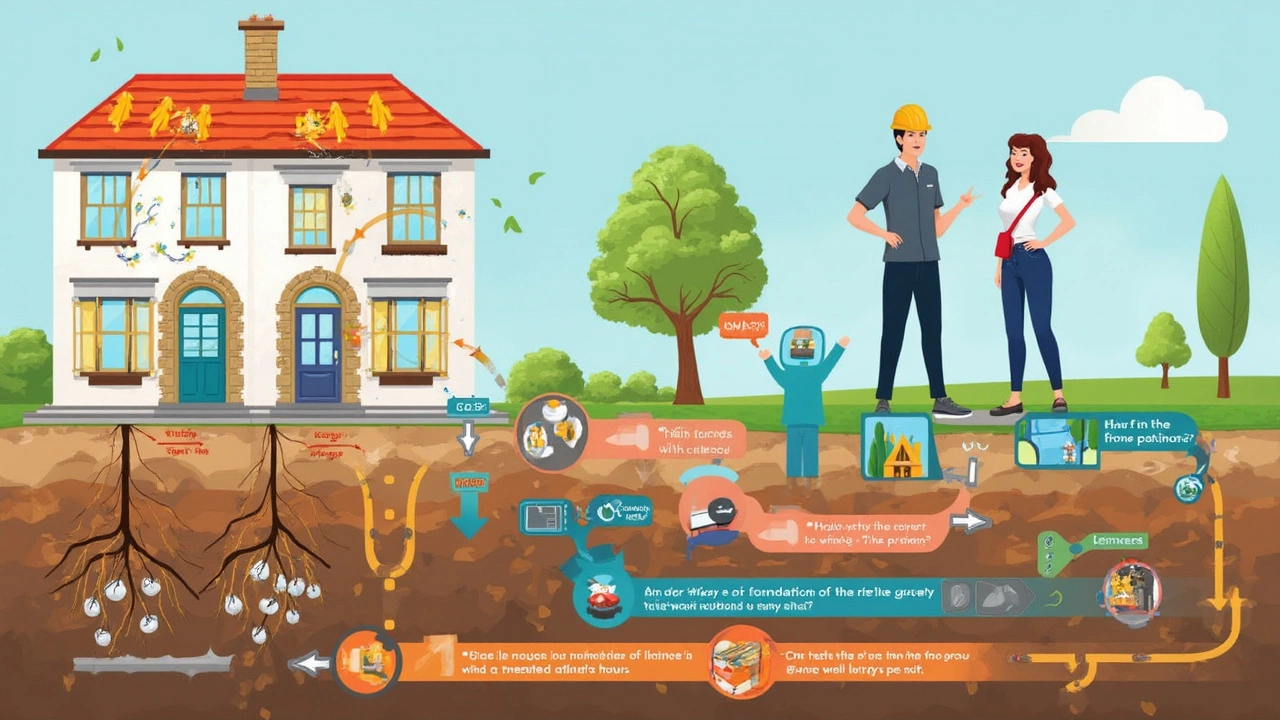Is Foundation Settling Normal?
 Feb, 11 2025
Feb, 11 2025
Ever notice a little crack in your wall and wonder if it's just the house settling or something more sinister? Yeah, you're not alone. Foundation settling is pretty common, but knowing when it's normal and when to freak out is key.
Let's get one thing straight: buildings settle. It's just the nature of things. So, don't panic at every creak and groan. Tiny shifts happen as soil under the house moves or compacts over time. This is what usually causes small cracks or uneven floors. If you're spotting minor gaps in your drywall or hairline cracks, it might just be your home doing its settling dance.
However, not all cracks and creaks are made equal. If you start noticing big, ominous cracks, doors sticking, or windows that don't open properly, it might be time to call in the pros. Foundation issues can lead to costly repairs if ignored, so knowing the difference is crucial.
There are ways to keep settling in check, like maintaining consistent soil moisture around the house and making sure water drains away from the foundation. Tiny tweaks like these can save you a headache in the long run. And if you're ever unsure, a quick consultation with a foundation repair specialist can give you peace of mind.
- Understanding Foundation Settling
- Signs That Settling is Normal
- When Settling Becomes a Problem
- Prevention Tips for Homeowners
- Seeking Professional Help
Understanding Foundation Settling
So, what's the deal with foundation settling? Simply put, it happens when the soil beneath your home shifts or compacts. We're talking about natural movements here—soil gets wet, then dry, shrinking and expanding over time. Even gravity has a say in how your house sits on its patch of earth.
Picture this: your home foundation is like the base of a sandcastle. It needs a stable surface to stand tall, but the ground isn't always predictable. Various factors come into play here—things like clay-heavy soil, weather changes, drainage issues, or nearby construction. These can all influence how much your home settles. Naturally, there's a threshold for what's considered 'normal'.
Normal vs. Excessive Settling
A bit of settling isn't the end of the world. Most houses see some slight movement without major repercussions. Typically, minor cosmetic cracks in walls or ceilings and slight unevenness in floors are par for the course. But when should you start worrying? If cracks exceed a quarter-inch width or appear in a stair-step pattern on brick walls, that could spell trouble.
Geographical Influence
Your home's location is a big player in the foundation settling game. For example, homeowners in regions with extreme weather variations might see more settling. In contrast, areas with stable climates may experience less shift. Check out this simple table to see how different types of soil affect settling:
| Soil Type | Settling Risk |
|---|---|
| Clay | High |
| Sandy | Low |
| Silt | Moderate |
It's good to know what you're dealing with under your house, so you can keep an eye on potential issues. Remember, understanding the ground under your home is a step towards keeping your heaven intact!
Signs That Settling is Normal
So, how do you know if your home is just experiencing some foundation settling or if it's a symptom of something bigger? The key is in the details. Home foundation changes can be subtle, and some signs are totally normal.
Minor Cracks
Not every crack is cause for alarm. If you're seeing thin, hairline cracks in your drywall or small gaps on the exterior bricks, you're probably in the safe zone. These cracks often appear in areas of natural stress, like door frames or window edges, and they're just your house adjusting with time. No need to panic here.
Uneven Floors
A slight slope in the floor might be a quirk of your house that adds character. If it's barely noticeable, it's likely just a bit of normal settling. Bust out a level if you're concerned, but a little bit of lean isn't an immediate red flag.
Small Gaps Around Windows and Doors
Ever notice a tiny gap around your window or door frame? This is pretty common and usually nothing to worry about. As your house settles slightly, frames might shift a bit. As long as you can still open and close everything without risking a hernia, you're good.
- Hairline cracks around doors and windows are common.
- Slight floor sloping is normal settling.
- Minor gaps in window and door frames are expected.
Normal Wear and Tear
Remember, homes aren't built in a bubble. They face varying weather, soil conditions, and years of gravity pulling on them, so a bit of settling is normal. Regular maintenance and being observant can help you catch any changes before they become costly problems.
For the most part, if these shifts are minor and don't grow or change over time, it's just part of your home foundation settling in its place. However, always keep an eye on them, and when in doubt, don't hesitate to reach out to a foundation repair expert.

When Settling Becomes a Problem
So, you've noticed a crack or two, and you're wondering if it's more than just foundation settling. This is where you need to keep your eyes peeled. Some telltale signs might indicate your home foundation is having trouble beyond usual settling.
Warning Signs to Watch Out For
- Wide Cracks: While tiny cracks are okay, cracks wider than a quarter of an inch could be cause for concern. These might mean the foundation is shifting more than it should be.
- Sticking Doors and Windows: If your doors and windows don't open or close like they used to, the frame might be misaligned due to foundation problems.
- Sloping Floors: Floors that are uneven or sloping more than usual can indicate foundational issues.
- Separation: If walls are separating from the ceiling or floor, that's a red flag.
These issues can escalate if not addressed. According to the American Society of Civil Engineers, "Ignoring or postponing repairs can lead to more extensive damage and increased repair costs."
"Foundations that show excessive movement require immediate expert evaluation to find sustainable solutions," says Michael J. Jones, a structural engineer with over 20 years experience.
Underlying Causes
What could be causing these issues? Often, problems stem from moisture levels around your foundation. Too much water can cause soil expansion, while too little can lead to contraction. Both scenarios are bad news as they cause the soil to shift.
Cost Implications
Just as a heads up, ignoring problems now could mean a big fat bill later. Foundation repairs can range from a few thousand bucks for minor repairs to tens of thousands for major overhauls. Getting ahead of the problem is crucial.
The key here? Act fast. If you spot any of these warning signs, call in a professional to assess the situation. It might save you from a financial headache down the road.
Prevention Tips for Homeowners
When it comes to dealing with foundation settling, an ounce of prevention is definitely worth a pound of cure. Let's check out some practical steps you can take to help keep your home foundation in tip-top shape.
Manage Water Around Your Foundation
Water is both a friend and foe to your foundation. Too much or too little can lead to settling issues. Make sure you have proper drainage systems, like gutters and downspouts, and keep them clean and functional.
- Regrade soil: Ensure the ground slopes away from your house.
- Install drainage: French drains or swales can be real lifesavers.
- Seasonal checks: Regularly check for ponding water near the foundation.
Maintain Consistent Soil Moisture
Soil moisture is key in keeping your foundation steady. During dry spells, water your foundation area, but don't overdo it. Aim for consistency.
- Watering schedule: Use soaker hoses around your foundation in the summer to prevent soil shrinking.
- Monitor moisture levels: Keep an eye out for soil pulling away from the foundation.
Keep an Eye on Trees and Shrubs
Plant roots can mess with your foundation by sucking moisture out of the soil or, worse, pushing into it.
- Tree placement: Plant trees and shrubs at a safe distance from your home.
- Root barriers: Consider installing root barriers for existing trees too close for comfort.
Annual Inspections
Finally, make it a habit to conduct annual inspections of your foundation. Look for cracks, uneven floors, or other changes, and address issues promptly. Early detection can save you big-time hassle and repairs down the line.
By taking these preventive measures, you'll be better equipped to handle settling issues and protect your investment. Remember, regular maintenance is the secret sauce to a healthy home foundation.

Seeking Professional Help
So, you think you might need some professional advice on your foundation repair? Don't sweat it, you're taking a smart step toward protecting your home. Getting experts involved can make a huge difference when you're facing serious foundation settling issues.
The first move is usually getting a qualified foundation inspector. These folks know all the nitty-gritty details about homes and have seen it all. They'll pop by and give your place a thorough review, checking out the cracks, slopes, and the overall condition of your foundation. The best part? They’ll understand what’s typical settling and what might be a red flag signaling something major.
Know When to Call
Think about calling in a professional when you start noticing troubling signs like wide cracks, doors or windows that won't shut, or walls that are bowing. An expert will not only confirm what's going on but give you a rundown of the best fixes available. Regular inspections can catch things early, saving you a bunch of time and money in the long term.
Picking the Right Pro
In the world of foundation repair, you’ve got choices. But not every company is created equal. Look for those guys with solid credentials, maybe a license or certification in structural engineering. Reviews from previous clients can also give you a good vibe about their reliability and quality of work.
- Check their qualifications and experience.
- Ask for references or reviews from past clients.
- Ensure they offer a detailed inspection report.
- Get a written estimate before committing.
Did you know about 90% of foundation repair issues can be fixed without replacing the foundation entirely? A good repair company will explore all options with you, ensuring minimal disruption and a solution that's both effective and budget-friendly.
Pricing and Project Timeline
Cost is usually a big question mark when thinking about repairs. The price tag usually factors in the severity of the damage and the solution needed. Basic fixes might just be a few hundred bucks, while more extensive repairs could climb into thousands. A reliable company should be clear on costs and timelines.
All in all, reaching out to the pros for your foundation issues can take a load off your mind. They’ll not only fix the current problem but help prevent future ones, keeping your home safe and sound for years to come.
